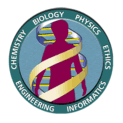skip
navigation
Genome
Glossary
All Terms
A B C D E F
G H I J
K L M
N O P Q
R S T
U V W X Y Z
|
H
-
Haploid
- A single set of chromosomes (half the full set of genetic material) present in the egg and sperm cells of animals and in the egg and pollen cells of plants. Human beings have 23 chromosomes in their reproductive cells.
See also:
diploid
-
Haplotype
- A way of denoting the collective genotype of a number of closely linked loci on a chromosome.
-
Hemizygous
- Having only one copy of a particular gene. For example, in humans, males are hemizygous for genes found on the Y chromosome.
-
Hereditary cancer
- Cancer that occurs due to the inheritance of an altered gene within a family.
See also:
sporadic cancer
-
Heterozygosity
- The presence of different alleles at one or more loci on homologous chromosomes.
-
Heterozygote
-
See:
heterozygosity
-
Highly conserved sequence
- DNA sequence that is very similar across several different types of organisms.
See also:
gene, mutation
-
High-throughput sequencing
- A fast method of determining the order of bases in DNA.
See also:
sequencing
-
Homeobox
- A short stretch of nucleotides whose base sequence is virtually identical in all the genes that contain it. Homeoboxes have been found in many organisms from fruit flies to human beings. In the fruit fly, a homeobox appears to determine when particular groups of genes are expressed during development.
-
Homolog
- A member of a chromosome pair in diploid organisms or a gene that has the same origin and functions in two or more species.
-
Homologous chromosome
- Chromosome containing the same linear gene sequences as another, each derived from one parent.
-
Homologous recombination
- Swapping of DNA fragments between paired chromosomes.
-
Homology
- Similarity in DNA or protein sequences between individuals of the same species or among different species.
-
Homozygote
- An organism that has two identical alleles of a gene.
See also:
heterozygote
-
Homozygous
-
See:
homozygote
-
Human artificial chromosome (HAC)
- A vector used to hold large DNA fragments.
See also:
chromosome, DNA
-
Human gene therapy
-
See:
gene therapy
-
Human Genome Initiative
- Collective name for several projects begun in 1986 by DOE to create an ordered set of DNA segments from known chromosomal locations, develop new computational methods for analyzing genetic map and DNA sequence data, and develop new techniques and instruments for detecting and analyzing DNA. This DOE initiative is now known as the Human Genome Program. The joint national effort, led by DOE and NIH, is known as the Human Genome Project.
-
Human Genome Project (HGP)
- Formerly titled Human Genome Initiative.
See also:
Human Genome Initiative
-
Hybrid
- The offspring of genetically different parents.
See also:
heterozygote
-
Hybridization
- The process of joining two complementary strands of DNA or one each of DNA and RNA to form a double-stranded molecule.
Updated 26-Apr-07
Return to home page
A B
C D E
F G
H I
J K
L M
N O
P Q
R S
T U
V W
X Y Z All
Terms
|
Last modified: Monday, February 01, 2010
Home * Contacts * Disclaimer
Document Use and Credits
Publications and webpages on this site were created by the U.S. Department of Energy Genome Program's Biological and Environmental Research Information System (BERIS). Permission to use these documents is not needed, but please credit the U.S. Department of Energy Genome Programs and provide the website http://genomics.energy.gov. All other materials were provided by third parties and not created by the U.S. Department of Energy. You must contact the person listed in the citation before using those documents.
Base URL: www.ornl.gov/hgmis
 Site sponsored by the U.S. Department of Energy
Office of Science, Office
of Biological and Environmental Research, Human
Genome Program Site sponsored by the U.S. Department of Energy
Office of Science, Office
of Biological and Environmental Research, Human
Genome Program
|
 Site sponsored by the U.S. Department of Energy
Office of Science, Office
of Biological and Environmental Research, Human
Genome Program
Site sponsored by the U.S. Department of Energy
Office of Science, Office
of Biological and Environmental Research, Human
Genome Program
